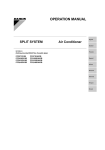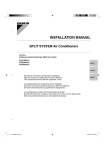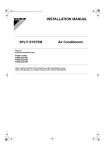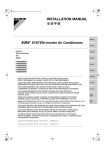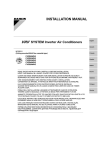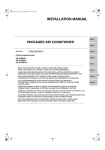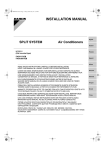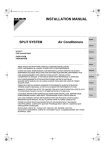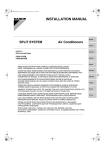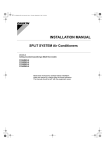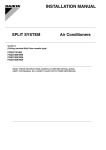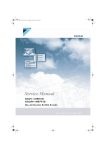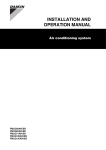Download Daikin FCQ140DAV3B Installation manual
Transcript
00_CV_3P184443-6.fm Page 1 Monday, July 3, 2006 9:02 AM INSTALLATION MANUAL English SPLIT SYSTEM Air Conditioners Deutsch MODELS (Ceiling mounted Multi flow cassette type) FCQ71DV3B FCQ100DV3B FCQ125DV3B FCQ140DV3B FCQ71DAV3B FCQ100DAV3B FCQ125DAV3B FCQ140DAV3B READ THESE INSTRUCTIONS CAREFULLY BEFORE INSTALLATION. KEEP THIS MANUAL IN A HANDY PLACE FOR FUTURE REFERENCE. LESEN SIE DIESE ANWEISUNGEN VOR DER INSTALLATION SORGFÄLTIG DURCH. BEWAHREN SIE DIESE ANLEITUNG FÜR SPÄTERE BEZUGNAHME GRIFFBEREIT AUF. Français Español Italiano ΕλληνικÜ Nederlands LIRE SOIGNEUSEMENT CES INSTRUCTIONS AVANT L’INSTALLATION. CONSERVER CE MANUEL A PORTEE DE MAIN POUR REFERENCE ULTERIEURE. Portugues LEA CUIDADOSAMENTE ESTAS INSTRUCCIONES ANTES DE INSTALAR. GUARDE ESTE MANUAL EN UN LUGAR A MANO PARA LEER EN CASO DE TENER ALGUNA DUDA. Рóссêий PRIMA DELL’INSTALLAZIONE LEGGERE ATTENTAMENTE QUESTE ISTRUZIONI. TENERE QUESTO MANUALE A PORTATA DI MANO PER RIFERIMENTI FUTURI. ÄΙΑΒΑΣΤΕ ΠΡΟΣΕΚΤΙΚΑ ΑΥΤΕΣ ΤΙΣ ΟÄΗΓΙΕΣ ΠΡΙΝ ΑΠΟ ΤΗΝ ΕΓΚΑΤΑΣΤΑΣΗ ΕΧΕΤΕ ΑΥΤΟ ΤΟ ΕΓΧΕΙΡΙÄΙΟ ΕΥΚΑΙΡΟ ΓΙΑ ΝΑ ΤΟ ΣΥΜΒΟΥΛΕΥΕΣΤΕ ΣΤΟ ΜΕΛΛΟΝ. LEES DEZE INSTRUCTIES ZORGVULDIG DOOR VOOR INSTALLATIE. BEWAAR DEZE HANDLEINDING WAAR U HEM KUNT TERUGVINDEN VOOR LATERE NASLAG. LEIA COM ATENÇÃO ESTAS INSTRUÇÕES ANTES DE REALIZAR A INSTALAÇÃO. MANTENHA ESTE MANUAL AO SEU ALCANCE PARA FUTURAS CONSULTAS. ПЕРЕД НАЧАЛОМ МОНТАЖА ВНИМАТЕЛЬНО ОЗНАКОМЬТЕСЬ С ДАННЫМИ ИНСТРУКЦИЯМИ. СОХРАНИТЕ ДАННОЕ РУКОВОДСТВО В МЕСТЕ, УДОБНОМ ДЛЯ ОБРАЩЕНИЯ В БУДУЩЕМ. EN60335-2-40, FCQ71DAV3B, FCQ100DAV3B, FCQ125DAV3B, FCQ140DAV3B FCQ71DV3B, FCQ100DV3B, FCQ125DV3B, FCQ140DV3B DAIKIN INDUSTRIES, LTD. 3P154437-1A Noboru Murata Manager Quality Control Department Sakai, 1st of October 2005 Umeda Center Bldg., 4-12, Nakazaki-Nishi 2-chome, Kita-ku, Osaka, 530-8323 Japan 2024351-QUA/EMC02-4565 KEMA DAIKIN.TCF.021 01_EN_3P184443-6.fm Page 1 Monday, July 3, 2006 12:04 PM FCQ71DV3B FCQ100DV3B FCQ125DV3B FCQ140DV3B FCQ71DAV3B FCQ100DAV3B FCQ125DAV3B FCQ140DAV3B SPLIT SYSTEM Air Conditioners Installation manual CONTENTS 1. 2. 3. 4. 5. 6. 7. 8. 9. 10. 11. 12. 13. SAFETY CONSIDERATIONS ........................................................................................1 BEFORE INSTALLATION ..............................................................................................3 SELECTING INSTALLATION SITE................................................................................5 PREPARATIONS BEFORE INSTALLATION .................................................................6 INDOOR UNIT INSTALLATION .....................................................................................8 REFRIGERANT PIPING WORK ....................................................................................9 DRAIN PIPING WORK .................................................................................................12 ELECTRIC WIRING WORK .........................................................................................15 WIRING EXAMPLE ......................................................................................................17 FIELD SETTING...........................................................................................................19 INSTALLATION OF THE DECORATION PANEL .......................................................... 21 TEST OPERATION ......................................................................................................21 WIRING DIAGRAM ......................................................................................................25 1. SAFETY CONSIDERATIONS Please read these “SAFETY CONSIDERATIONS” carefully before installing air conditioning equipment and be sure to install it correctly. After completing the installation, make sure that the unit operates properly during the start-up operation. Please instruct the customer on how to operate the unit and keep it maintained. Also, inform customers that they should store this installation manual along with the operation manual for future reference. This air conditioner comes under the term “appliances not accesible to the general public”. Meaning of warning and caution symbols. WARNING .........Failure to observe a warning may result in death or serious injury. CAUTION ..........Failure to observe a caution may result in injury or damage to the equipment. • • • • • WARNING Ask your dealer or qualified personnel to carry out installation work. Do not try to install the air conditioner yourself. Improper installation may result in water leakage, electric shocks or fire. Perform installation work in accordance with this installation manual. Improper installation may result in water leakage, electric shocks or fire. Be sure to use only the specified accessories and parts for installation work. Failure to use the specified parts may result in water leakage, electric shocks, fire or the unit falling. Install the air conditioner on a foundation strong enough to withstand the weight of the unit. A foundation of insufficient strength may result in the equipment falling and causing injuries. Carry out the specified installation work after considering strong winds, typhoons or earthquakes. Improper installation work may result in the equipment falling and causing accidents. English 1 01_EN_3P184443-6.fm Page 2 Monday, July 3, 2006 12:04 PM • Make sure that a separate power supply circuit is provided for this unit and that all electrical work is carried out by qualified personnel according to local laws and regulations and this installation manual. An insufficient power supply capacity or improper electrical construction may lead to electric shocks or fire. • Make sure that all wiring is secured, the specified wires and used, and no external forces act on the terminal connections or wires. Improper connections or installation may result in fire. • When wiring the power supply and connecting the wiring between the indoor and outdoor units, position the wires so that the terminal box lid can be securely fastened. Improper positioning of the terminal box lid may result in electric shocks, fire or the terminals overheating. • If the refrigerant gas leaks during installation, ventilate the area immediately. Toxic gas may be produced if the refrigerant gas comes into contact with fire. • After completing the installation work, check that the refrigerant gas does not leak. Toxic gas may be produced if the refrigerant gas leaks into the room and comes into contact with a source of fire, such as a fan heater, stove or cooker. • Before touching electrical parts, turn off the unit. • Be sure to establish an earth. Do not earth the unit to a utility pipe, arrester, or telephone earth. Incomplete earth may cause electrical shock, or fire. A high surge current from lightning or other sources may cause damage to the air conditioner. • Be sure to install an earth leakage breaker. Failure to install an earth leakage breaker may result in electric shocks, or fire. • • • • • 2 CAUTION While following the instructions in this installation manual, install drain piping in order to ensure proper drainage and insulate piping in order to prevent condensate. Improper drain piping may result in water leakage and property damage. Install the indoor and outdoor units, power supply wiring and connecting wiring at least 1 meter away from televisions or radios in order to prevent image interference or noise. (Depending on the radio waves, a distance of 1 meter may not be sufficient enough to eliminate the noise.) Remote controller (wireless kit) transmitting distance can result shorter than expected in rooms with electronic fluorescent lamps. (inverter or rapid start types) Install the indoor unit as far away from fluorescent lamps as possible. Do not install the air conditioner in the following locations: (a) where a mineral oil mist or an oil spray or vapor is produced, for example in a kitchen Plastic parts may deteriorate and fall off or result in water leakage. (b) where corrosive gas, such as sulfurous acid gas, is produced Corroding copper pipes or soldered parts may result in refrigerant leakage. (c) near machinery emitting electromagnetic waves Electromagnetic waves may disturb the operation of the control system and result in a malfunction of the equipment. (d) where flammable gases may leak, where there are carbon fiber or ignitable dust suspensions in the air, or where volatile flammables such as thinner or gasoline are handled. Operating the unit in such conditions may result in fire. Make sure to provide for adequate measures in order to prevent that the outdoor unit be used as a shelter by small animals. Small animals making contact with electrical parts can cause malfunctions, smoke or fire. Please instruct the customer to keep the area around the unit clean. English 01_EN_3P184443-6.fm Page 3 Monday, July 3, 2006 12:04 PM 2. BEFORE INSTALLATION Do not exert pressure on the resin parts when opening the unit or when moving it after opening Be sure to check the type of R410A refrigerant to be used before doing any work. (Using an incorrect refrigerant will prevent normal operation of the unit.) • When opening the unit or moving it after opening, be sure to lift it by holding on to the lifting lugs without exerting any pressure on other parts, especially, drain piping, and other resin parts. • Decide upon a line of transport. • Leave the unit inside its packaging while moving, until reaching the installation site. Use a sling of soft material, where unpacking is unavoidable or protective plates together with a rope when lifting, to avoid damage or scratches to the unit. • Refer to the installation manual of the outdoor unit for items not described in this manual. • Do not dispose of any parts necessary for installation until the installation is complete. 1. PRECAUTIONS • • • • Be sure to read this manual before installing the indoor unit. When selecting installation site, refer to the paper pattern. This unit is suitable for installation in a household, commercial and light industrial environment. Do not install or operate the unit in rooms mentioned below. • Laden with mineral oil, or filled with oil vapor or spray like in kitchens. (Plastic parts may deteriorate.) • Where corrosive gas like sulfurous gas exists. (Copper tubing and brazed spots may corrode.) • Where volatile flammable gas like thinner or gasoline is used. • Where machines can generate electromagnetic waves. (Control system may malfunction.) • Where the air contains high levels of salt such as that near the ocean and where voltage fluctuates greatly such as that in factories. Also in vehicles or vessels. 2. ACCESSORIES Check the following accessories are included with your unit. Name (1) Drain hose (2) Metal clamp Quantity 1 pc. 1 pc. (3) Washer for hanger bracket (4) Clamp (5) Paper pattern for installation 8 pcs. 1 pc. 8 pcs. Also used as packing material Shape Name (6) Screw (M5) (7) Washer fixing plate Insulation for fitting Quantity 4 pcs. 4 pcs. 1 each For paper pattern for installation Sealing pad 1 each (8) for gas pipe (10) Large (9) for liquid pipe (11) Medium Shape English 1 pc. (12) Small (Other) • Installation manual • Operation manual 3 01_EN_3P184443-6.fm Page 4 Monday, July 3, 2006 12:04 PM 3. OPTIONAL ACCESSORIES • The optional decoration panel and remote controller are required for this indoor unit. (Refer to Table 1, 2) (However, the remote controller is not required for the slave unit of a simultaneous operation system.) Table 1 Unit model Optional decoration panel BYCP125DJW1, BYCP125DAW1 Color : White FCQ71·100·125·140 • These are two types of remote controllers: wired and wireless. Select a remote controller from Table 2 according to customer request and install in an appropriate place. Table 2 Wired type Wireless type Remote controller BRC1D527, BRC1D528, BRC1C61 BRC7E51W, BRC7EA51W NOTE • If you wish to use a remote controller that is not listed in “Table 2” on page 4, select a suitable remote controller after consulting catalogs and technical materials. FOR THE FOLLOWING ITEMS, TAKE SPECIAL CARE DURING CONSTRUCTION AND CHECK AFTER INSTALLATION IS FINISHED. 1. Items to be checked after completion of work Items to be checked Are the indoor unit and outdoor unit fixed firmly? Is the gas leak test finished? Is the unit fully insulated? Does drainage flow smoothly? Does the power supply voltage correspond to that shown on the name plate? Are wiring and piping correct? Is the unit safely grounded? Is wiring size according to specifications? Is something blocking the air outlet or inlet of either the indoor or outdoor units? Are refrigerant piping length and additional refrigerant charge noted down? If not properly done, what is likely to occur Check The unit may drop, vibrate or make noise. It may result in insufficient cooling. Condensate water may drip. Condensate water may drip. The unit may malfunction or the components burn out. The unit may malfunction or the components burn out. It may result in electric shock. The unit may malfunction or the components burn out. It may result in insufficient cooling. The refrigerant charge in the system is not clear. 2. Items to be checked at time of delivery * Also review the “1. SAFETY CONSIDERATIONS” Items to be checked Check Did you explain about operations while showing the instruction manual to your customer? Did you hand the instruction manual over to your customer? 4 English 01_EN_3P184443-6.fm Page 5 Monday, July 3, 2006 12:04 PM Points for explanation about operations The items with WARNING and CAUTION marks in the instruction manual are the items pertaining to possibilities for bodily injury and material damage in addition to the general usage of the product. Accordingly, it is necessary that you make a full explanation about the described contents and also ask your customers to read the instruction manual. 4. NOTE TO THE INSTALLER Be sure to instruct customers how to properly operate the unit (especially cleaning filters, operating different functions, and adjusting the temperature) by having them carry out operations themselves while looking at the manual. 3. SELECTING INSTALLATION SITE *≥1500 Air discharge ≥1500 ≥2500 For installation in high places H Please attach additional thermal insulation material to the unit body when it is believed that the relative humidity in the ceiling exceeds 80%. Use glass wool, polyethylene foam, or similar with a thickness of 10 mm or more as thermal insulation material. (1) Select an installation site where the following conditions are fulfilled and that meets your customer’s approval. • In the upper space (including the back of the ceiling) of the indoor unit where there is no possible dripping of water from the refrigerant pipe, drain pipe, water pipe, etc. • Where optimum air distribution can be ensured. • Where nothing blocks air passage. • Where condensate can be properly drained. • Where the ceiling is strong enough to bear the indoor unit weight. • Where the false ceiling is not noticeably on an incline. • Where sufficient clearance for maintenance and service can be ensured. • Where there is no risk of flammable gas leakage. • Where piping between indoor and outdoor units is possible within the allowable limit. (Refer to the installation manual for the outdoor unit.) [Space required for installation] *≥1500 *≥1500 Air Air discharge inlet *≥1500 *≥1500 Fig. 1 *≥1500 Fig. 2 NOTE • Leave 200 mm or more space where marked with the *, on sides where the air outlet is closed. Model FCQ71 FCQ100·125·140 English H 256 298 5 01_EN_3P184443-6.fm Page 6 Monday, July 3, 2006 12:04 PM CAUTION • Any vents, light fixtures, or other appliances which may disturb the airflow might cause the top side to become dirty if located too nearby, so follow the figure below when installing. • Keep indoor unit, outdoor unit, power supply wiring and transmission wiring at least 1 meter away from televisions and radios. This is to prevent image interference and noise in those electrical appliances. (Noise may be generated depending on the conditions under which the electric wave is generated, even if 1 meter is kept.) (2) Ceiling height • Install this unit where the height of bottom panel is more than 2.5 m so that the user cannot easily touch. • This indoor unit may be installed on ceilings up to 3.5 m in height. However, it becomes necessary to make field settings by remote controller and close the air outlet when installing the unit at a height over 2.7 m. Refer to the section entitled, “10. FIELD SETTING” and the decoration panel installation manual. (3) Use suspension bolts for installation. Check whether the ceiling is strong enough to support the weight of the unit or not. If there is a risk, reinforce the ceiling before installing the unit. (Installation pitch is maked on the paper pattern for installation. Refer to it to check for points requiring reinforcing.) 4. PREPARATIONS BEFORE INSTALLATION 780 (Suspension bolt pitch) Refrigerant piping Hanger bracket False ceiling 680(Suspension bolt pitch) 840 (Indoor unit) 860 – 910 (Ceiling opening) 950 (Decoration panel) Suspension bolt (×4) View as seen from A (150) 860 – 910 (Ceiling opening) 840 (Indoor unit) 950 (Decoration panel) (1) Relation of ceiling opening to unit and suspension bolt position. Fig. 4 A Fig. 3 6 English 01_EN_3P184443-6.fm Page 7 Monday, July 3, 2006 12:04 PM 910 (Dimension inside frame) 840 Installation is possible when ceiling opening dimensions is as follows • When installing the unit within the frame for fixing false ceiling. 860 (Opening dimension inside the flame for ceiling) Frame False ceiling ≥20 840 910 (Dimension inside frame) ≥20 860 – *910 (Ceiling opening dimension) (Ceiling-panel overlapping dimension) Fig. 6 Fig. 5 NOTE • Installation is possible with a ceiling dimension of 910 mm (marked with *). However, to achieve a ceilingpanel overlapping dimension of 20 mm, the spacing between the ceiling and the unit should be 35 mm or less. If the spacing between ceiling and the unit is over 35 mm, attach ceiling material to part or recover the ceiling. Ceiling material ≥ 35 ≥ 35 Fig. 7 (2) Make the ceiling opening needed for installation where applicable. (For existing ceilings) • Refer to the paper pattern for installation (5) for ceiling opening dimensions. • Create the ceiling opening required for installation. From the side of the opening to the casing outlet, implement the refrigerant and drain piping and wiring for remote controller (unnecessary for wireless type) and indoor-outdoor unit casing outlet. Refer to “6. REFRIGERANT PIPING WORK”, “7. DRAIN PIPING WORK” and “8. ELECTRIC WIRING WORK”. • After making an opening in the ceiling, it may be necessary to reinforce ceiling beams to keep the ceiling level and to prevent it from vibrating. Consult the builder for details. <installation example> Ceiling slab Anchor Long nut or turn-buckle Suspension bolt 50 – 100 (3) Install the suspension bolts. (Use either a M8~M10 size bolt) Use a hole-in anchor for existing ceilings, and a sunken insert, sunken anchor or other field supplied parts for new ceilings to reinforce the ceiling to bear the weight of the unit. Adjust clearance (50 – 100 mm) from the ceiling before proceeding further. False ceiling Fig. 8 NOTE • All the above parts are field supplied. English 7 01_EN_3P184443-6.fm Page 8 Monday, July 3, 2006 12:04 PM 5. INDOOR UNIT INSTALLATION Installing optional accessories (except for the decoration panel) before installing the indoor unit is easier. However, for existing ceilings, install fresh air inlet component kit and branch duct before installing the unit. As for the parts to be used for installation work, be sure to use the provided accessories and specified parts designated by our company. (1) For new ceilings (1-1)Install the indoor unit temporarily. • Attach the hanger bracket to the suspension bolt. Be sure to fix it securely by using a nut and washer (3) from the upper and lower sides of the hanger bracket. The washer fixing plate (7) will prevent the washer from falling. Field supply Washer (3) (attached) Insert Hanger bracket Washer fixing plate (7) (attached) Tighten (double nuts) [Securing the hanger bracket] [Securing the washer] Fig. 9 Fig. 10 (1-2)Refer to the paper pattern for installation (5) for ceiling opening dimension. Consult the builder or carpenter for details. • The center of the ceiling opening is indicated on the paper pattern for installation. The center of the unit is indicated on the triangular mark to the unit bottom and on the paper pattern for installation. • Fix the paper pattern to the unit with screws (6) (×4). • Ceiling height is shown on the side of the paper pattern for installation (5). Adjust the height of the unit according to this indication. Please perform one of the following, as the shape of the paper pattern for installation differs according to the model. Only the corner where the pipes go out, the screw is already fixed at the drain pan. Center of ceiling opening False ceiling LOWER SURFACE OF THE CEILING (Height adjustment of the unit.) Paper pattern for installation (5) Screw (6) (attached) Screw (6) (attached) Fig. 11 [Installation of paper pattern for installation] 8 English 01_EN_3P184443-6.fm Page 9 Monday, July 3, 2006 12:04 PM <Ceiling work> (1-3)Adjust the unit to the right position for installation. (Refer to “4. PREPARATIONS BEFORE INSTALLATION-(1)”.) (1-4)Check the unit is horizontally level. CAUTION • The indoor unit is equipped with a built-in drain pump and float switch. Verify that it is level by using a level or a water-filled vinyl tube. (If the unit is tilted against condensate flow, the float switch may malfunction and cause water to drip.) Level (1-5)Remove the washer fixing plate (7) used for preventing the washer from falling and tighten the upper nut. (1-6)Remove the paper pattern for installation (5). Vinyl tube [Maintaining horizontality] Fig. 12 (2) For existing ceilings (2-1)Install the indoor unit temporarily. • Attach the hanger bracket to the suspension bolt. Be sure to fix it securely by using nut and washer from upper/lower sides of hanger bracket. If you use the washer fixing plate (7), it will prevent the falling of the washer. Field supply Washer (3) (attached) Insert Hanger bracket Tighten (double nuts) Washer fixing plate (7) (attached) [Securing the hanger bracket] [Securing the washer] Fig. 13 Fig. 14 (2-2)Adjust the height and position of the unit. (Refer to “4.PREPARATIONS BEFORE INSTALLATION-(1)”.) (2-3)Perform steps (1-4), (1-5) in (1) For new ceilings. 6. REFRIGERANT PIPING WORK 〈For refrigerant piping of outdoor units, see the installation manual attached to the outdoor unit.〉 〈Execute heat insulation work completely on both sides of the gas piping and the liquid piping. Otherwise, a water leakage can result sometimes.〉 (When using a heat pump, the temperature of the gas piping can reach up to approximately 120°C, so use insulation which is sufficiently resistant.) 〈Also, in cases where the temperature and humidity of the refrigerant piping sections might exceed 30°C or RH80 %, reinforce the refrigerant insulation. (20 mm or thicker) Condensate may form on the surface of the insulating material.〉 〈Be sure to check the type of R410A refrigerant to be used before doing any work. (Using an incorrect refrigerant will prevent normal operation of the unit.)〉 • • • • CAUTION Use a pipe cutter and flare suitable for the type of refrigerant. Apply ester oil or ether oil around the flare section before connecting. To prevent dust, moisture or other foreign matter from infiltrating the tube, either pinch the end or cover it with tape. Do not allow anything other than the designated refrigerant to get mixed into the refrigerant circuit, such as air, etc. If any refrigerant gas leaks while working on the unit, ventilate the room thoroughly right away. English 9 01_EN_3P184443-6.fm Page 10 Monday, July 3, 2006 12:04 PM • The outdoor unit is charged with refrigerant. • Be sure to use both a spanner and torque wrench together, as shown in the drawing, when connecting or disconnecting pipes to/from the unit. (Refer to Fig. 15) • Refer to “Table 3” for the dimensions of flare nut spaces. Torque wrench Spanner Pipe union Flare nut Fig. 15 • When connecting the flare nut, apply ester oil or ether oil to the flare section (both inside and outside), and spin 3-4 times before screwing in. (Refer to Fig. 16) Coat here with ester or ether oil. CAUTION Over-tightening the flare nut may break it and/or cause the refrigerant to leak. Fig. 16 NOTE • Use the flare nut included with the unit main body. Table 3 φ 9.5 (3/8”) 32.7 – 39.9 N·m 12.8 – 13.2 φ 15.9 (5/8”) 61.8 – 75.4 N·m 19.3 – 19.7 Flare 45˚±2˚ Flare dimensions A (mm) R0.4-0.8 A Tightening torque 90˚±0.5˚ Pipe size • Refer to “Table 3” to determine the proper tightening torque. Not recommendable but in case of emergency You must use a torque wrench but if you are obliged to install the unit without a torque wrench, you may follow the installation method mentioned below After the work is finished, make sure to check that there is no gas leak. When you keep on tightening the flare nut with a spanner, there is a point where the tightening torque suddenly increases. From that position, further tighten the flare nut the angle shown below: Pipe size φ 9.5 (3/8”) φ 15.9 (5/8”) 10 Further tightening angle 60 to 90 degrees 30 to 60 degrees Recommended arm length of tool Approx. 200mm Approx. 300mm English 01_EN_3P184443-6.fm Page 11 Monday, July 3, 2006 12:04 PM • Make absolutely sure to execute heat insulation works on the pipe-connecting section after checking gas leakage by thoroughly studying the following figure and using the attached heat insulating materials for fitting (8) and (9). (Fasten both ends with the clamps (4).) (Refer to Fig. 17) • Wrap the sealing pad (11) only around the insulation for the joints on the gas piping side. (Refer to Fig. 17) Medium sealing pad (attached) (11) (Wrap the piping union with the sealing pad.) Clamp (4) (×4) Insulation for fitting (attached) (9) (for liquid line) Insulation for fitting (attached) (8) (for gas line) Liquid piping Gas piping Fig. 17 CAUTION For local insulation, be sure to insulate local piping all the way into the pipe connections inside the machine. Exposed piping may cause condensation or burns on contact. CAUTION CAUTION TO BE TAKEN WHEN BRAZING REFRIGERANT PIPING “Do not use flux when brazing refrigerant piping. Therefore, use the phosphor copper brazing filler metal (BCuP-2: JIS Z 3264/B-Cu93P-710/795: ISO 3677) which does not require flux.” (Flux has extremely harmful influence on refrigerant piping systems. For instance, if the chlorine based flux is used, it will cause pipe corrosion or, in particular, if the flux contains fluorine, it will damage the refrigerant oil.) • Before brazing local refrigerant piping, nitrogen gas shall be blown through the piping to expel air from the piping. If you brazing is done without nitrogen gas blowing, a large amount of oxide film develops inside the piping, and could cause system malfunction. • When brazing the refrigerant piping, only begin brazing after having carried out nitrogen substitution or while inserting nitrogen into the refrigerant piping. Once this is done, connect the indoor unit with a flared or a flanged connection. • Nitrogen should be set to 0.02MPa with a pressure-reducing valve if brazing while inserting nitrogen into the piping. (Refer to Fig. 18) Pressure-reducing valve Refrigerant piping Taping Part to be Hands valve brazed Nitrogen Nitrogen Fig. 18 English 11 01_EN_3P184443-6.fm Page 12 Monday, July 3, 2006 12:04 PM 7. DRAIN PIPING WORK (1) Rig drain piping • As for drain work, perform piping in such a manner that water can be drained properly. As for drain piping, the connection can be made from three different directions. • Employ a pipe with either the same diameter or with the diameter larger (excluding the raising section) than that of the connecting pipe (PVC pipe, nominal diameter 25 mm, outside diameter 32 mm). • Keep the drain pipe short and sloping downwards at a gradient of at least 1/100 to prevent air pockets from forming. • If the drain pipe cannot be sufficiently set on a slope, execute the drain raising piping. • To keep the drain pipe from sagging, space hanging wires every 1 to 1.5 m. Hanger bracket 1–1.5 m 1/100 gradient or more GOOD WRONG Fig. 19-1 Fig. 19-2 CAUTION Water pooling in the drainage piping can cause the drain to clog. • Use the attached drain hose (1) and Metal clamp (2). • Insert the drain hose into the drain socket up to the base, and tighten the Metal clamp securely within the portion of a white tape of the hose-inserted tip. Tighten the Metal clamp until the screw head is less than 4 mm from the hose. • Wrap the attached sealing pad (10) over the Metal clamp and drain hose to insulate. • Make sure that heat insulation work is executed on the following 2 spots to prevent any possible water leakage due to dew condensation. • Indoor drain pipe • Drain socket Metal clamp (2) Metal clamp (2) (attached) Large sealing pad (10) (attached) Drain hose (1) Tape (White) Fig. 20 12 Fig. 21 ≥ 4 mm English 01_EN_3P184443-6.fm Page 13 Monday, July 3, 2006 12:04 PM <PRECAUTIONS FOR DRAIN RAISING PIPING> • Install the drain raising pipes at a height of less than 550 mm. • Install the drain raising pipes at a right angle to the indoor unit and no more than 300 mm from the unit. To prevent air bubbles in the drain hose part, keep it level or slightly tilted up. Any bubbles in the hose might cause the unit to make noise due to backflow when the drain pump stops. Drain raising pipe Metal clamp (attached) (2) Adjustable ( ≥ 550) ≥ 750 Level or tilted slightly up Hanger bracket 200 Ceiling slab ≥ 300 mm 1 – 1.5 m Drain hose (1) (accessory) Raising section Drain hose (attached) (1) Fig. 22 ≥100 mm NOTE • To ensure no excessive pressure is applied to the included drain hose (1), do not bend or twist when installing. (This may cause leakage.) • If converging multiple drain pipes, install according to the procedure shown below. Slope downwards at a gradient of at least 1/100 T-joint converging drain pipes Fig. 23 Select converging drain pipes whose gauge is suitable for the operating capacity of the unit. (2) After piping work is finished, check if drainage flows smoothly. • Add approximately 2000 cc of water slowly from the air outlet and check drainage flow. WHEN ELECTRIC WIRING WORK IS FINISHED • Check drainage flow during COOL running, explained under ‘‘12. TEST OPERATION’’. WHEN ELECTRIC WIRING WORK IS NOT FINISHED CAUTION • Electrical wiring work should be done by a certified electrician. • If someone who does not have the proper qualifications performs the work, perform the following after the test run is complete. • Remove the terminal box lid. Connect the single phase power supply (SINGLE PHASE 50Hz 230V, 240V) to connections No.1 and No.2 on the terminal block for wiring the units. Do not connect to No.3 of the terminal block for wiring the units. (The drain pump will not operate.) Connect the ground wire firmly. When carrying out wiring work around the terminal box, make sure none of the connectors come undone. Be sure to attach the terminal box lid before turning on the power. • After confirming drainage (Fig.24, Fig.25), turn off the power and remove the power supply. • Attach the terminal box lid as before. English 13 01_EN_3P184443-6.fm Page 14 Monday, July 3, 2006 12:04 PM ≥100 Drain pipe Plastic watering can (Tube should be about 100 mm long.) Service drain outlet (with rubber plug) (Use this outlet to drain water from the drain pan) <Adding water through air discharge outlet> [Method of adding water] Fig. 24 Ground terminal Clamp (Field supply) Terminal block for wiring the units 1 2 3 Single phase power supply (50Hz 230V, 240V) Terminal box lid Fig. 25 CAUTION Drain piping connections Do not connect the drain piping directly to sewage pipes that smell of ammonia. The ammonia in the sewage might enter the indoor unit through the drain pipes and corrode the heat exchanger. 14 English 01_EN_3P184443-6.fm Page 15 Monday, July 3, 2006 12:04 PM 8. ELECTRIC WIRING WORK • • • • • • • All field supplied parts and materials and electric works must conform to local codes. Use copper wire only. For electric wiring work, refer to also “WIRING DIAGRAM” attached to the unit body. For remote controller wiring details, refer to the installation manual attached to the remote controller. All wiring must be performed by an authorized electrician. A circuit breaker capable of shutting down power supply to the entire system must be installed. Refer to the installation manual attached to the outdoor unit for the size of power supply electric wire connected to the outdoor unit, the capacity of the circuit breaker and switch, and wiring instructions. • Be sure to ground the air conditioner. • Do not connect the ground wire to gas pipes, plumbing pipes, lightning rods, or telephone ground wires. • Gas pipes: might cause explosions or fire if gas leaks. • Plumbing: no grounding effect if hard vinyl piping is used. • Telephone ground wires or lightning rods: might cause abnormally high electric potential in the ground during lighting storms. • Specifications for field wire The remote control cord should be procured locally. Refer to the Table 4 when preparing one. Table 4 Wire Wiring the units Remote controller cord H05VV – U4G (NOTE 1) Vinyl cord with sheath or cable NOTE 2 (2 wire) 2 Size (mm ) 2.5 0.75 – 1.25 Length – Max. 500 m * *This will be the total extended length in the system when doing group control. NOTE 1. Shows only in case of protected pipes. Use H07RN-F in case of no protection. 2. Vinyl cord with sheath or cable (Insulated thickness : 1mm or more) Connection of wiring between units, ground wire and for the remote controller cord (Refer to Fig. 26) • Wiring the units and ground wire Remove the terminal box lid and connect wires of matching number to the terminal block for wiring the units (3 P) inside. And connect the ground wire to the ground terminal. In doing this, pull the wires inside through the hole and fix the wires securely with the included clamp (4) (2 points). • Remote controller cords (not neccessary for slave unit of simultaneous operation system) Remove the terminal box lid and pull the wires inside through the hole and connect to the terminal block for remote controller (6 P). (no polarity) Securely fix the remote controller cord with the included clamp (4) (2 points). • After connection, attach sealing pad (12) • Be sure to attach it to prevent the infiltration of water from the outside. English 15 01_EN_3P184443-6.fm Page 16 Monday, July 3, 2006 12:04 PM Ground terminal *Be sure to attach it to prevent the infiltration of water from the outside. Note) Wrap it around the wire Sealing pad (12) without leaving any space Remote controller cord Wiring between units Wiring (Outside) (Inside) [How to attach sealing pads] Note) (If there are more than 2 pieces of power supply wires, divide the sealing pad (small) (12) into some pieces and wrap them around each wire.) Outdoor unit 1 2 3 1 2 3 Clamp (4) After securing the cramp material to the bracket, cut off any extra material. Indoor unit Terminal block for wiring the units Remote controller cord (Wiring between unit) How to connect the terminal blocks for wiring the units (3P) Terminal block for remote controller (6P) Terminal box lid WIRING DIAGRAM P 1 P 2 F1 F 2 Fig. 26 Remote controller cord (Ground the shield part of shielded wire. Refer to NOTE 2 in “9. WIRING EXAMPLE”) Observe the notes mentioned below when wiring to the terminal block for wiring the units. • • • • CAUTION When clamping wiring, use the included clamping material to prevent outside pressure being exerted on the wiring connections and clamp firmly. When doing the wiring, make sure the wiring is neat and does not cause the terminal box lid to stick up, then close the cover firmly. When attaching the terminal box lid, make sure you do not pinch any wires. After all the wiring connections are done, fill in any gaps in the through holes with putty or insulation (procured locally) to prevent small animals and insects from entering the unit from outside. (If any do get in, they could cause short circuits in the terminal box.) Outside the machine, separate the weak wiring (remote controller cord) and strong wiring (interunit, ground, and other power wiring) at least 50 mm so that they do not pass through the same place together. Proximity may cause electrical interference, malfunctions, and breakage. 16 English 01_EN_3P184443-6.fm Page 17 Monday, July 3, 2006 12:04 PM • Do not connect wires of different gauge to the same power supply terminal. (Looseness in the connection may cause overheating.) (Refer to Fig. 28) • Observe the notes when wiring to the terminal block for wiring the units. (Use a round crimp-style terminal with insulation sleeve for connection to the terminal block for wiring the units. In case it cannot be used due to unavoidable reasons, connect wires of the same gauge to the both side as shown in Fig. 28.) Attach insulation sleeve Round crimp-style terminal Fig. 27 Connect wires of the same gauge to both side. (GOOD) Good Do not connect wires of the same gauge to one side. (WRONG) Wrong Electric wire Do not connect wires of different gauges. (WRONG) Wrong Fig. 28 Follow the instructions below if the wiring gets very hot due to slack in the power wiring. • In wiring, make certain that prescribed wires are used, carry out complete connections, and fix the wires so that outside forces are not applied to the terminals. • Use the correct screwdriver for tightening the terminal screws. If the blade of screwdriver is too small, the head of the screw might be damaged, and the screw will not be properly tightened. • If the terminal screw are tightened too hard, screws might be damaged. • Refer to the table below for the tightening torque of the terminal screws. Tightening torque (N·m) Terminal block for remote controller 0.79 to 0.97 Terminal block for wiring the units 1.18 to 1.44 Ground terminal 1.44 to 1.94 9. WIRING EXAMPLE For the wiring of outdoor units, refer to the installation manual attached to the outdoor units. Confirm the system type. • Pair type: 1 remote controller controls 1 indoor unit. (standard system) (Refer to Fig. 29) • Simultaneous operation system: 1 remote controller controls 2 indoor units. (2 indoor units operates equally) (Refer to Fig. 30) • Group control: 1 remote controller controls up to 16 indoor units. (All indoor units operate according to the remote controller) (Refer to Fig. 31) • 2 remote controllers control: 2 remote controllers control 1 indoor unit. (Refer to Fig. 32) English 17 01_EN_3P184443-6.fm Page 18 Monday, July 3, 2006 12:04 PM Simultaneous operation system Pair type Main power supply Main power supply Main switch Fuse Main switch Fuse Outdoor unit Outdoor unit 1 2 3 1 2 3 1 2 3 1 2 3 1 2 3 P1 P2 P1 P2 Indoor unit Indoor unit (Master) P1 P2 Indoor unit (Slave) P1 P2 P1 P2 Remote controller (Optional accessory) Remote controller (Optional accessory) Fig. 29 Fig. 30 Group control 2 remote controllers control Main power supply Main power supply Main power supply Main power supply Main switch Fuse Main switch Fuse Main switch Fuse Outdoor unit Outdoor unit Outdoor unit Main switch Fuse Outdoor unit 1 2 3 1 2 3 1 2 3 1 2 3 1 2 3 1 2 3 1 2 3 1 2 3 P1 P2 Indoor unit P1 P2 Indoor unit P1 P2 P1 P2 P1 P2 Indoor unit Indoor unit Remote controller (Optional accessory) Fig. 31 P1 P2 P1 P2 Remote controller Fig. 32 Remote controller (Slave) (Optional accessories) NOTE 1. All transmission wiring except for the remote controller wires is polarized and must match the terminal symbol. 2. In case a shielding wire is to be used, connect a shielded portion with the of a terminal block for remote controller. (Also, connect the ground for the remote control to a grounded metal part.) 3. In case of group control, perform the remote controller wiring to the master unit when connecting to the simultaneous operation system. (wiring to the slave unit is unnecessary) 4. For group control remote controller, choose the remote controller that suits the indoor unit which has the most functions (as attached swing flap) 5. For simultaneous operation system, connect the remote controller cord to the master unit. 6. When controlling the simultaneous operation system with 2 remote controllers, connect it to the master unit. (wiring to the slave unit is unnecessary) 18 English 01_EN_3P184443-6.fm Page 19 Monday, July 3, 2006 12:04 PM 10. FIELD SETTING Make sure the terminal box lids are closed on the indoor and outdoor units. Field setting must be made from the remote controller and in accordance with installation conditions. • Setting can be made by changing the “Mode No”, “FIRST CODE NO.” and “SECOND CODE NO.”. • For setting procedures and instructions, see “Field settings” provided with the remote controller. 10-1 Setting ceiling height • Select the SECOND CODE NO. that corresponds to the ceiling height “Table 5”. (SECOND CODE NO. is factory set to “01” for a ceiling height of less than 2.7m .) Table 5 Ceiling height (m) FCQ71 FCQ100·125·140 Less than 2.7 m Less than 3.2m N More than 2.7 m; More than 3.2m; H 3.0 m or less 3.6m or less More than 3.0 m; More than 3.6m; S 3.5 m or less 4.2m or less Mode No. * FIRST CODE NO. SECOND CODE NO. 01 13 (23) 0 02 03 See the installation manual included with the sealing material of air discharge outlet kit, sold separately and technical guide, for ceiling height settings for two and three-direction air discharge. 10-2 Setting when installing high performance filters • In case of installing high performance filters, refer to the option handbook of the high performance filters. 10-3 Setting air filter sign • Remote controllers are equiped with liquid crystal display air filter signs to display the time to clean air filters. • Change the SECOND CODE NO. according to “Table 6” depending on the amount of dirt or dust in the room. (SECOND CODE NO. is factory set to “01” for filter contamination-light.) Table 6 Setting Spacing time of display air filter sign (long life type) Air filter contaminationlight Air filter contaminationheavy Mode No. * FIRST CODE NO. 10 (20) 0 Approx. 5000 hrs SECOND CODE NO. 01 Approx. 2500 hrs 02 10-4 Setting indoor unit number of simultaneous operation system • When using in simultaneous operation system mode, change the SECOND CODE NO. as shown in “Table 7”. (SECOND CODE NO. is factory set to “01” for Number Pair system.) Table 7 Setting Pair system (1 unit) Simultaneous operation system (2-unit) Mode No. * FIRST CODE NO. 11 (21) 0 SECOND CODE NO. 01 02 • When using in simultaneous operation system mode, refer to “10-5 Simultaneous operation system individual setting” on page 20 section to set master and slave units separately. English 19 01_EN_3P184443-6.fm Page 20 Monday, July 3, 2006 12:04 PM When using wireless remote controllers • When using wireless remote controllers, wireless remote controller address setting is necessary. Refer to the installation manual attached to the wireless remote controller for setting instructions. 10-5 Simultaneous operation system individual setting It is easier if the optional remote controller is used when setting the slave unit. • Perform the following procedures when setting the master and slave unit separately. Procedure (1) Change the SECOND CODE NO. to “02”, individual setting, so that the slave unit can be individually set. (SECOND CODE NO. is factory set to “01”, unified setting.) Setting Unified setting Individual setting (2) (3) (4) (5) (6) (7) (8) (9) Mode No.* FIRST CODE NO. 11 (21) 1 SECOND CODE NO. 01 02 Perform field setting for the master unit. Turn off the main power supply switch after (2). Detach remote controller from the master unit and connect it to the slave unit. Turn on the main power supply switch again, and as in (1), change the SECOND CODE NO. to “02”, individual setting. Perform field setting for the slave unit. Turn off the main power supply switch after (6). If there is more than one sub-unit, repeat steps (4) – (7). Detach the remote controller from the slave unit after the setting, and reattach to the master unit. This is the end of the setting procedure. *You do not need to rewire the remote controller from the master unit if the optional remote controller for slave unit is used. (However, remove the wires attached to the remote controller terminal board of the master unit.) (Refer to Fig. 30 on “9. WIRING EXAMPLE”) 10-6 When implementing group control • When using as a pair unit or as a parent unit for simultaneous operation multi, you may simultaneous start/ stop (group) control up to 16 unit with the remote controller. • In this case, all the indoor units in the group will operate in accordance with the group control remote controller. • Select a remote controller which matches as many of the functions (swing flap, etc) in the group as possible. Outdoor unit 1 Indoor unit 1 Outdoor unit 2 Indoor unit 2 Outdoor unit 3 Indoor unit 3 Group control remote controller Fig. 33 Wiring Method (1) Remove the terminal box lid. (See ‘‘8. ELECTRIC WIRING WORK’’.) (2) Cross-wire the terminal block for remote controller (P1 P2) inside the terminal box. (There is no polarity.) (Refer to Fig. 31 and Table 4) 20 English 01_EN_3P184443-6.fm Page 21 Monday, July 3, 2006 12:04 PM 10-7 Control by 2 Remote Controllers (Controlling 1 indoor unit by 2 remote controllers) • When using 2 remote controllers, one must be set to “MAIN” and the other to “SUB”. MAIN/SUB CHANGEOVER (1) Insert a screwdriver into the recess between the upper and lower part of remote controller and, working from the 2 positions, pry off the upper part. (The remote controller PC board is attached to the upper part of remote controller.) (Refer to Fig. 34) (2) Turn the main/sub changeover switch on one of the two remote controller PC boards to “S”. (Leave the switch of the other remote controller set to “M”.) (Refer to Fig. 35) Upper part of remote controller (Factory setting) (Only one remote controller needs to be changed if factory settings have remained untoched.) Lower part of remote controller Insert the screwdriver here and gently work off the upper part of remote controller. Fig. 34 S M S M Remote controller PC board Fig. 35 Wiring Method (See ‘‘8. ELECTRIC WIRING WORK’’) (3) Remove the terminal box lid (4) Add remote controller 2 (slave) to the terminal block for remote controller (P1, P2) in the terminal box. (There is no polarity.) (Refer to Fig. 32 and Table 4) PRECAUTION For simultaneous operation system, connect the remote controller cord to the master unit. 11. INSTALLATION OF THE DECORATION PANEL <Read ‘‘12. TEST OPERATION’’ before making a test run without attaching the decorated panels.> Refer to the installation manual attached to the decoration panel. After installing the decoration panel, ensure that there is no space between the unit body and decoration panel. 12. TEST OPERATION Refer to the section of “FOR THE FOLLOWING ITEMS, TAKE SPECIAL CARE DURING CONSTRUCTION AND CHECK AFTER INSTALLATION IS FINISHED.” . • After finishing the construction of refrigerant piping, drain piping, and electric wiring, conduct test operation accordingly to protect the unit. 12-1 HOW TO TEST OPERATION 1. 2. 3. 4. 5. 6. 7. 8. 9. Open the gas side stop valve. Open the liquid side stop valve. Electrify crank case heater for 6 hours. Set to cooling operation with the remote controller and start operation by pushing ON/OFF button ( ). Press INSPECTION/TEST OPERATION button ( ) 4 times (2 times for wireless remote controller) and operate at Test Operation mode for 3 minutes. Push AIR FLOW DIRECTION ADJUST button ( ) to make sure the unit is in operation. Press INSPECTION/TEST OPERATION button ( ) and operate normally. Confirm function of unit according to the operation manual. If the decoration panel has not been installed, turn off the power after the test operation. English TEST TEST 21 01_EN_3P184443-6.fm Page 22 Monday, July 3, 2006 12:04 PM PRECAUTIONS 1. Refer to the diagnoses below if the unit does not operate properly. 2. After completing the test run, press the INSPECTION/TEST OPERATION button once to put the unit in inspection mode, and make sure the malfunction code is “00”. (=normal) If the code reads anything other than “00”, refer to the malfunction diagnoses below. NOTE • If a malfunction is preventing operation, refer to the malfunction diagnoses below. 12-2 Cautions for servicing With the power on. Troubles can be monitored on the remote controller. • If the air conditioner does not operate normally after installing the air conditioner. a malfunction shown in the table below may happened. Remote control display No display 88* 88 flashing • • • • • • • • • Malfunction Power supply trouble or Open phase connection Wrong wiring between indoor and outdoor unit Indoor PC board faulty Wrong remote control conection wiring Remote control faulty Fuse faulty Indoor PC board faulty Wrong wiring between indoor and outdoor unit Wrong wiring between indoor and outdoor unit *After turning on the power, the maximum is 90 seconds, although it will only display “88”. This is not a problem, and it will be set for 90 seconds. ■ Trouble shooting with the display on the liquid crystal display remote controller. 1. With the wired remote controller. (Note 1) When the operation stops due to trouble, operation lamp flashed, and “ ” and the Malfunction code are indicated on the liquid crystal display. In such a case, diagnose the fault contents by refering to the table on the Malfunction code list it case of group control, the unit No. is displayed so that the indoor unit no with the trouble can be recognized. (Note 2) 2. With the wireless remote controller. (Refer also to the operation manual attached to the wireless remote controller) When the operation stops due to trouble. the display on the indoor unit flashes. In such a case, diagnose the fault contents with the table on the Malfunction code list looking for the Malfunction code which can be found by following procedures. (Note 2) (1) Press the INSPECTION /TEST OPERATION button, “ ” is displayed and “ 0 ” flashes. (2) Press the PROGRAMMING TIME button and find the unit No. which stopped due to trouble. Number of beeps 3 short beeps Perform all the following operations 1 short beep Perform (3) and (6) 1 long beep No trouble (3) Press the OPERATION MODE SELECTOR button and upper figure of the Malfunction code flashes. (4) Continue pressing the PROGRAMMING TIME button unit it makes 2 short beeps and find the upper code. (5) Press the Operation selector button and lower figure of the Malfunction code flashes. (6) Continue pressing the PROGRAMMING TIME button unit it makes a long beep and find the lower code. • A long beep indicate the Malfunction code. NOTE 1. In case wired remote controller. Press the INSPECTION /TEST OPERATION button on remote controller, “ ” starts flashing and changes the inspection mode. 2. Keep down the ON/OFF button for 5 seconds or longer in the inspection mode and the above trouble history disappears, after the trouble code goes on and off twice, followed by the code “00”(normal). The display changes from the inspection mode to the normal mode. 22 English 01_EN_3P184443-6.fm Page 23 Monday, July 3, 2006 12:04 PM 12-3 Malfunction code list • For plases where the Malfunction code is left blank, the “ ” indication is not displayed. Though the system continues operating, be sure to inspect the system and make repairs as necessary. • Depending on the type of indoor or outdoor unit, the Malfunction code may or may not be displayed. Code A1 A3 A6 AF AH AJ C4 C9 CC CJ E0 E1 E3 E4 E5 E7 E9 F3 H3 H4 H7 H9 JA JC J3 J5 J6 L4 L5 L8 English Malfunction/Remarks Indoor unit’s PC board faulty Drain water level abnormal Indoor fan motor overloaded, overcurrent or locked Humidifier faulty Air cleaner faulty Only the air cleaner does not function. Type set improper Capacity data is wrongly proset. Or there is nothing programmed in the data hold IC. Sensor for heat exchanger temperature is fault Sensor for suction air temperature is fault Humidity sensor abnormal Sensor for remote controller is fault The remote controller thermistor does not function, but the system thermo run is possible. Action of safety device (outdoor unit) Outdoor unit’s PC board faulty High pressure abnormal(outdoor unit) Low pressure abnormal (outdoor unit) Compressor motor lock malfunction Outdoor fan motor lock malfunction Outdoor fan instantneous overcurrent malfunction Electronic expansion valve faulty (outdoor unit) Discharge pipe temperature abnormal (outdoor unit) High pressure switch faulty (outdoor unit) Low pressure switch faulty (outdoor unit) Outdoor motor position signal malfunction Outdoor air thermistor faulty (outdoor unit) Equipment operation in response to errors will vary according to model. Discharge pipe pressure sensor faulty Suction pipe pressure sensor faulty Discharge pipe thermistor faulty (outdoor unit) Equipment operation in response to errors will vary according to model. Suction pipe thermistor faulty (outdoor unit) Heat exchanger thermistor faulty (outdoor unit) Equipment operation in response to errors will vary according to model. Overheated heat-radiating fin (outdoor unit) Inverter cooling defect. Instantaneous overcurrent (outdoor unit) Possible earth fault or short circuit in the compressor motor. Electric thermal (outdoor unit) Possible electrical overload in the compressor or cut line in the compressor motor. 23 01_EN_3P184443-6.fm Page 24 Monday, July 3, 2006 12:04 PM L9 LC P1 P3 P4 PJ U0 U1 U2 U4 UF U5 U8 UA UC 24 Stall prevention (outdoor unit) Compressor possibly locked. Transmission malfunction between the outdoor control units’ inverters (outdoor unit) Open-phase (outdoor unit) P-board temperature sensor malfunction (outdoor unit) Heat-radiating fin temperature sensor malfunction (outdoor unit) Type set improper (outdoor unit) Capacity data is wrongly proset. Or there is nothing programmed in the data hold IC. Suction pipe temperature abnormal Reverse phase Reverse two phase of the L1,L2and L3 leads. Power source voltage malfunction (outdoor unit) Includes the defect in 52C. Transmission error (indoor unit – outdoor unit) Wrong wiring between indoor and outdoor units or malfunction of the PC board mounted on the indoor and the outdoor units. Transmission error (indoor unit – remote controller) Transmission is improper between the indoor unit and the remote controller. Malfunction in transmission between main and sub remote controls. (Malfunction in sub remote controller.) Miss setting for multi system Setting is wrong for selector switch of multi-system. (see switch SS2 on the main unit’s PC board) Central control address overlapping English English BS1 (HUMIDITY SENSOR UNIT) SELECTOR SWITCH NOISE FILTER POWER CIRCUIT SIGNAL RECEIVER CIRCUIT SIGNAL TRANSMISSION Z2C PC RC TC SELECTOR SWITCH 3D048876-1A (MAIN/SUB) THERMISTOR (AIR) R1T SS1 WIRED REMOTE CONTROLLER CIRCUIT NOISE FILTER Z1C X2M TERMINAL STRIP X1M TERMINAL STRIP (EMERGENCY) FLOAT SWITCH S1L THERMISTOR (COIL) R2T SS1 THERMISTOR (AIR) R1T M1S MOTOR (SWING FLAP) M1P MOTOR (DRAIN PUMP) M1F MOTOR (INDOOR FAN) KPR MAGNETIC RELAY (M1P) (SERVICE MONITOR GREEN) (WIRELESS ADDRESS SET) SELECTOR SWITCH (MAIN/SUB) SELECTOR SWITCH (DEFROST-ORANGE) LIGHT EMITTING DIODE (FILTER SIGN-RED) LIGHT EMITTING DIODE (TIMER-GREEN) LIGHT EMITTING DIODE (ON-RED) LIGHT EMITTING DIODE PUSH BUTTON (ON/OFF) PRINTED CIRCUIT BOARD (CONTROL ADAPTOR) X35A CONNECTOR (ADAPTOR FOR WIRING) X33A CONNECTOR CONNECTOR FOR OPTIONAL PARTS SS2 SS1 H4P H3P H2P H1P (CONTROL) PRINTED CIRCUIT BOARD A5P PRINTED CIRCUIT BOARD A4P PRINTED CIRCUIT BOARD TO WIRELESS REMOTE CONTROLLER) RECEIVER/DISPLAY UNIT (ATTACHED (POWER SUPPLY) INDOOR UNIT PRINTED CIRCUIT BOARD HAP LIGHT EMITTING DIODE A3P A2P A1P CONTROL BOX (INDOOR UNIT) WIRED REMOTE CONTROLLER NOTE) 2 CENTRAL REMOTE CONTROLLER NOTE) 5 NOTE) 5 RECEIVER/DISPLAY UNIT FCQ71 • 100 • 125 • 140DV3B, FCQ71 • 100 • 125 • 140DAV3B NOTES) : FIELD WIRING , : CONNECTOR : TERMINAL 1. 2. IN CASE USING CENTRAL REMOTE CONTROLLER, CONNECT IT TO THE UNIT IN ACCORDANCE WITH THE ATTACHED INSTALLATION MANUAL. 3. REMOTE CONTROLLER MODEL VARIES ACCORDING TO THE COMBINATION SYSTEM, CONFIRM ENGINEERING DATA AND CATALOGS, ETC. BEFORE CONNECTING. 4. CONFIRM THE METHOD OF SETTING THE SELECTOR SWITCH (SS1,SS2) BY INSTALLATION MANUAL AND ENGINEERING DATA, ETC. 5. GROUND THE SHIELD OF THE REMOTE CONTROLLER CORD TO THE INDOOR UNIT (IN CASE OF USING SHIELD WIRE). 6. SYMBOLS SHOWS AS FOLLOWS: RED: RED BLK: BLACK WHT: WHITE YLW: YELLOW GRN: GREEN ORG: ORANGE BRN: BROWN PNK: PINK GRY: GRAY BLU: BLUE REMOTE CONTROLLER IN CASE OF SIMULTANEOUS OPERATION SYSTEM INDOOR UNIT INDOOR UNIT TO (SLAVE) OUTDOOR (MASTER) UNIT TO OUTDOOR UNIT WIRING DIAGRAM 01_EN_3P184443-6.fm Page 25 Monday, July 3, 2006 12:04 PM 13. WIRING DIAGRAM 25 00_CV_3P184443-6.fm Page 2 Monday, July 3, 2006 9:02 AM 3P184443-6 EM04A037B (0608) HT




























